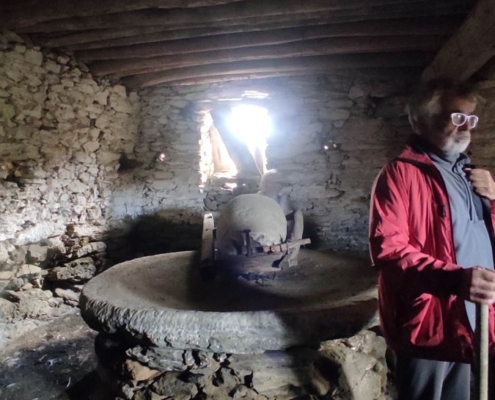Report of the 16th maintenance hike: Chartes, a sweet isolated surprise of NW Andros
Text: Katerina Pantazi
Photos/Videos: Maria Kyritsi, Pantelis Siabanos, Antonis Sassalos, Katerina Pantazi
English translation: Katerina Pantazi
On Saturday, November 9th, we held the 16th maintenance hike for 2024 in northern Andros, specifically on the circular route of Chartes marked Cha1!
The group was large, a total of 28 people from Ormos Korthiou, Gavrio, Batsi, Ano Korthi, Fellos, Kypri, Remmata, Varidi, Mainites and also from Germany. Also hikers who traveled from Attica just to walk with us! The strong wind that was blowing and the cloudy weather did not dampen the team’s enthusiasm.
The host and Route Angel Michalis Tridimas welcomed us and spoke about the name Chartes. Chartes is the last village of Andros at Cavo D’oro and belongs to the community of Makrotantalos along with 5 other settlements. The village has twenty houses, six of which are inhabited all year round and the inhabitants have always been cattle breeders, farmers and beekeepers.
And while the landscape that stretched around us was dry with few trees, bushes, olive trees and fig tress… it suddenly changed when we reached the pre-war concrete bridge covered by countless trees and plants. Michalis told us that the river from which the whole village is irrigated had so much water that the need for a bridge was imperative. We didn’t see enough water because water scarcity is a common phenomenon in Andros, but the adjacent ruined olive mill seems to confirm what Michalis said.
Right next to the bridge the olive mill of the Mourikis family which still stands operated until the 1960s. The warehouses where the olives were stored, the voli, i.e. the large stone where the olives were crushed with the help of an animal, the “vida” screw where the pulp of olives was put into the chantils and pressed to drain the oil, the worker, i.e. the vertical wooden shaft that was rotated by 2 men to operate the screw, all in very good condition as if waiting to be put into operation.
Next stop was the church of Agia Mavra. We admired the iconostasis and learned that the memory of Saint Mavra is celebrated on May 3rd unless it falls within Easter Lent, in which case it is transferred to the week after Easter. In any case, the festival is big and all the houses in the village organise the traditional greeting.
The route then crosses the area of Spartia with its ruined houses, gets somewhat close to the beach of Megala Peza and passes behind the Fasa lighthouse offering amazing views towards Cavo D’oro and inland towards Kalyvari. Making a small detour to the abandoned settlement of Agios Yiannis from where the last inhabitant left 30 years ago, we visited the apiary of the Athanasiou family. Michalis, who is a beekeeper himself, explained to us the uniqueness of these buildings and how they served the needs of beekeepers.
Passing the church of Agios Yiannis and the cemetery, we headed downhill to cross another dry stream and the neighborhood of Tambouri before walking the dirt road and ending up back at our starting point.
Our route ended in the sweetest way: with a tour of the old olive mill and current apiary of the Tridima family “3 melisses” where we tasted different types of honey and were offered homemade donuts with pollen, pumpkin and cheese with honey, chocolates made with honey and hot raki with honey.
The path is in very good condition: we pruned vegetation, collected a bag of litter and replaced worn signs.
We sincerely thank all participants, Katerina Dafniotidou who opened the church of Agia Mavra especially for us and Michalis Tridimas and his family for the interesting tour and the warm hospitality.
Click here https://androsresearchcenter.org/en/paragwgoi/ to view our digital map and find all local producers, processors and sellers of Andros products in relation to the routes maintained by Andros Route Angels!








































